Course
AWS Athena is a powerful, serverless query service that enables you to analyze data directly in Amazon S3 using standard SQL without complex ETL processes or infrastructure management.
In this blog post, we’ll explore Athena’s unique features, compare it to Amazon Redshift, outline its key features and benefits, and guide you through setting it up for data querying step-by-step!
What Is AWS Athena?
AWS Athena is an interactive query service that allows users to analyze data directly in Amazon S3 using standard SQL.
With Athena, you can run SQL queries on large datasets stored in S3 without complex ETL processes, making it a powerful tool for quick data exploration and in-depth analysis. This flexibility enables rapid insight generation, whether you’re examining a single CSV file or querying large, partitioned datasets.
A key advantage of AWS Athena is its serverless architecture, which eliminates the need to manage underlying infrastructure—no provisioning, scaling, or server management is required. Athena automatically scales to accommodate any data size, from gigabytes to petabytes, without manual intervention.
The serverless design reduces overhead and simplifies rapid experimentation and deployment, particularly in environments with fluctuating workloads.
Athena’s serverless architecture is also cost-effective, with no upfront costs—users only pay for the queries they run.
Features of AWS Athena
Here are some features that make Athena a unique service in the AWS ecosystem.
1. Serverless architecture
As I mentioned, AWS Athena operates on a serverless architecture, meaning you don't have to manage or configure servers. This design allows Athena to automatically scale based on the size and complexity of the queries, from small datasets to massive, multi-petabyte workloads.
The serverless model eliminates the need for upfront infrastructure costs, and you only pay for the queries you execute, making it both flexible and cost-efficient.
2. Integration with AWS Glue and other services
Athena integrates with AWS Glue, including the Glue Data Catalog, a fully managed metadata repository.
AWS Glue can automatically crawl data sources to discover and catalog your datasets, storing table definitions, schema, and location information in the Glue Data Catalog. This integration enables Athena users to query datasets easily without manually defining schemas or managing metadata.
The Glue Data Catalog also supports features like versioning, schema evolution, and data lineage tracking, which enhance the manageability and traceability of your data assets.
Additionally, Athena integrates with other AWS services, such as Amazon QuickSight for data visualization, AWS CloudTrail for auditing, and Amazon S3 for data storage. This tight integration allows users to build comprehensive data pipelines and analytics solutions within the AWS ecosystem.
3. Support for standard SQL
Athena supports standard SQL, allowing you to query data in S3 using familiar SQL syntax. This support ensures new and experienced data practitioners can write and execute queries without learning a new language.
Athena's SQL engine is based on Presto, an open-source distributed SQL query engine that provides powerful and flexible querying capabilities, including support for complex joins, window functions, and array and map data types.
4. Support for various data formats
Athena can query data stored in various formats, including CSV, JSON, Avro, Parquet, and ORC. By supporting columnar formats like Parquet and ORC, Athena optimizes query performance and cost by scanning only the necessary columns, reducing the amount of data processed.
5. Scalability, partition and performance
Athena is built to handle queries on datasets of any size, scaling automatically to meet the demands of your workload. It runs queries in parallel by default, enabling it to process large-scale queries efficiently.
Athena allows you to partition your data in S3, dramatically improving query performance and reducing costs. By organizing your data into partitions (e.g., by date or region), Athena can scan only the relevant portions of your dataset, minimizing the amount of data processed.
6. Security and compliance features
Athena offers robust security features to protect your data and ensure compliance with various regulations. It integrates with AWS Identity and Access Management (IAM) to manage access control, allowing you to define who can access specific datasets and query capabilities.
Additionally, Athena supports encryption for data at rest and in transit, ensuring that your data remains secure. It also complies with various industry standards and regulations, making it suitable for use in environments with strict compliance requirements.
Become a Data Engineer
Benefits of Using Amazon Athena
With the features we just mentioned in mind, here’s a concise overview of the advantages of Athena:
|
Benefit |
Feature |
Description |
|
Cost Efficiency |
Pay-per-query model |
Only pay for the data your queries interact with; no upfront costs or complex licenses; cost optimization is possible with partitioning, data compression, and columnar formats. |
|
Ease of Use |
Serverless & Standard SQL |
No need to set up or manage infrastructure; users can start querying data within minutes using familiar SQL syntax, making it accessible and straightforward to use. |
|
Flexibility |
Multi-format support |
It supports a wide range of data formats (e.g., CSV, JSON, Parquet), allowing users to query data in its native format directly from S3 without requiring ETL processes. |
|
Quick Insights |
Rapid analysis & direct S3 queries |
It enables immediate data analysis with serverless architecture, allowing for quick extraction of insights directly from data stored in S3 and reducing the time-to-value for data-driven decisions. |
Common Use Cases for Amazon Athena
We have defined Athena and mentioned its features and benefits, but what is it used for? In this section, we will review some of the most popular use cases.
Log analysis
Amazon Athena is frequently used for log analysis, particularly for querying and analyzing logs stored in Amazon S3. Organizations often generate massive volumes of log data from various sources, such as application logs, server logs, and access logs.
By storing these logs in S3 and querying them using Athena, users can quickly identify trends, diagnose issues, and monitor system performance without needing a complex setup.
- Example: A company might use Athena to analyze web server logs stored in S3, helping to identify patterns in user behavior, detect anomalies such as unexpected spikes in traffic, or troubleshoot errors in real time.
Ad-hoc data exploration
Athena’s serverless architecture and support for standard SQL make it an excellent tool for ad-hoc data exploration. Whether you’re a data scientist, analyst, or engineer, Athena lets you quickly query data stored in S3 without loading it into a traditional database.
- Example: A data analyst might use Athena to explore a new dataset just ingested into S3, running quick queries to understand the data’s structure, detect anomalies, or identify specific metrics before performing a more detailed analysis.
Querying data lakes
As organizations increasingly adopt data lakes to store vast amounts of raw and processed data, Athena serves as a powerful query engine for these data lakes. It allows users to perform analytics directly on data stored in S3, making it an integral part of a modern data lake architecture.
- Example: An organization might use Athena to query a data lake containing customer transaction data, product information, and sales records, enabling business users to generate reports and insights without needing a data warehouse.
Business intelligence reporting
Athena is also commonly used as part of a business intelligence (BI) stack, where it integrates with BI tools like Amazon QuickSight to enable data visualization and reporting. By querying data in S3 with Athena and visualizing it in QuickSight, organizations can create interactive dashboards and reports for decision-making.
- Example: A company might use Athena to query sales data stored in S3 and then connect the results to QuickSight to create a dashboard that tracks monthly sales performance, customer acquisition costs, and other vital metrics.
Amazon Athena vs Redshift
If you’re familiar with Amazon Redshift, you may wonder how it differs from Athena.
While both Athena and Redshift deal with datasets, their goals are different. Redshift’s primary use case is data warehousing and regular analytics involving big data. AWS Athena is focused on allowing users to perform ad hoc analysis on data stored in S3.
Here’s a detailed comparison of Athena vs Redshift:
|
Criteria |
Amazon Athena |
Amazon Redshift |
|
Architecture |
Serverless query service; runs SQL queries directly on data stored in Amazon S3 with automatic scaling; no infrastructure management. |
Fully managed data warehouse; requires a data warehouse cluster with dedicated infrastructure; can scale based on needs. The Redshift Serverless option is available. |
|
Use Cases |
It is ideal for ad-hoc querying and analytics on S3 data and for scenarios prioritizing flexibility and cost-efficiency without data transformation. |
Suited for complex, large-scale analytics and reporting; ideal for structured data requiring frequent querying and transformations. |
|
Cost Structure |
Pay-per-query model: charges based on data scanned by queries, making it cost-effective for intermittent or varying workloads. |
Pricing is based on cluster size and usage; reserved instance pricing is available for predictable, high-volume queries. |
|
Performance |
Dependent on data size and format; optimized by partitioning and compression; best for smaller, less complex queries. |
High performance for complex queries; uses columnar storage, parallel processing, and advanced optimization for intensive workloads. |
|
Data Integration |
Directly queries data in S3 without needing transformation or loading; supports various formats and extensible connectors, including Redshift. |
It requires data to be loaded into the warehouse, integrates with AWS services, and supports various data ingestion methods but reads only from its stored data. |
Setting Up AWS Athena
It’s time to get hands-on, set up Athena, and run some queries!
1. Creating an AWS account
Using AWS Athena requires an AWS account. If you don't have one, you must create one. To do so, follow the instructions in the AWS set-up guide.
While there is no free tier for AWS Athena, you should be able to run 2-3 small test queries (~10MB in size) to understand how the system works. Follow the instructions on the portal and verify your identity. Then log in to your AWS account.
2. Setting up permissions
Like all Amazon AWS products, Athena utilizes IAM (identity and access management) policies for permissions. You will be the root user for your account and should have the permissions necessary to run Athena queries on your own S3 buckets.
You can manage IAM permissions by searching for the IAM service in the top search bar in your AWS home dashboard and utilizing this complete IAM guide. The AWS documentation also provides more information on Athena's specific setup.

3. Configuring Athena to access data in Amazon S3
Before running queries, we need to set up an S3 bucket to store our data.
Amazon S3 stands for Simple Storage Service and is a critical component of how AWS manages storage and data within the cloud environment. Following this well-written guide on creating Amazon S3 buckets, we can create the storage environment for our data and queries.
In short, you will look for the S3 service in the search bar to get to the S3 homepage:
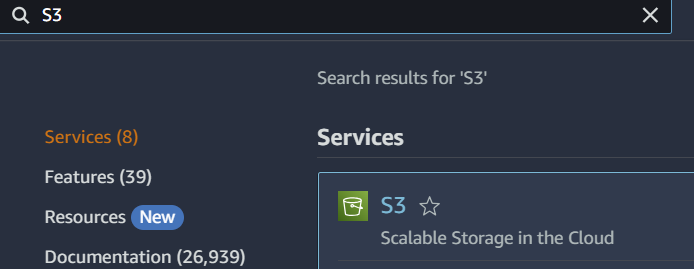
You will see a “Create Bucket” button on the right sidebar on the homepage. Following the instructions on this page, you will create a bucket that will allow your Athena service to store query results.
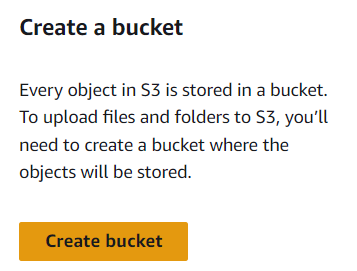
I will create a bucket called “athenadatacampguide” using all other default options. Because buckets must be globally unique across AWS, you must choose another name for this tutorial.
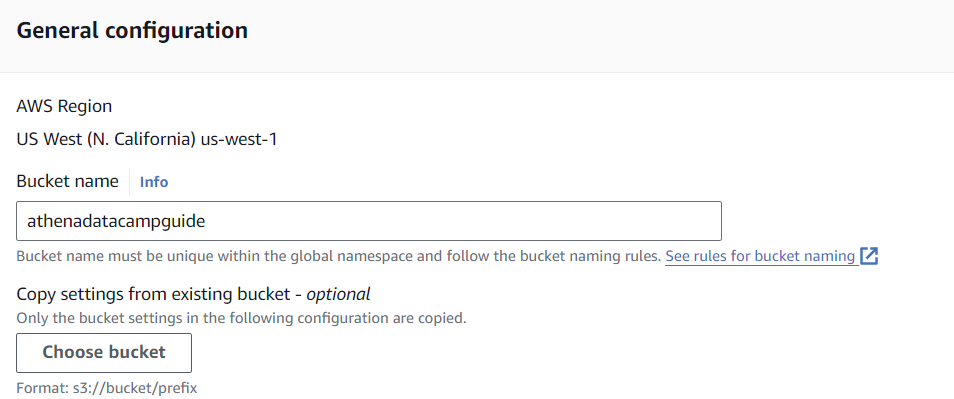
Now, we need to connect this bucket to Athena. I will go to the Athena console and click “Edit Settings” in the small notification bar near the top.

I will then select the bucket I just created. To find your bucket, use the “Browse S3” button on the right or type the name prefixed by “s3://.”
Once the bucket is selected, click “Save” and return it to the Editor by clicking on it in the top toolbar.

4. Creating a database
AWS Athena organizes data hierarchically. It utilizes “data catalogs,” a group of databases also known as schema.
The actual tables we query are within the databases. To create a new data catalog, you could use Amazon Lambda and connect to an external data source. The data catalog can then be saved as either a Lambda, Hive, or Glue data catalog.
The default on AWS is to use the Glue service as the central data catalog repository. We will focus on building a database that will hold our tables for querying.
In the Editor, go to the Query Editor pane. This is where we will write our queries to create databases, query tables, and run analytics.
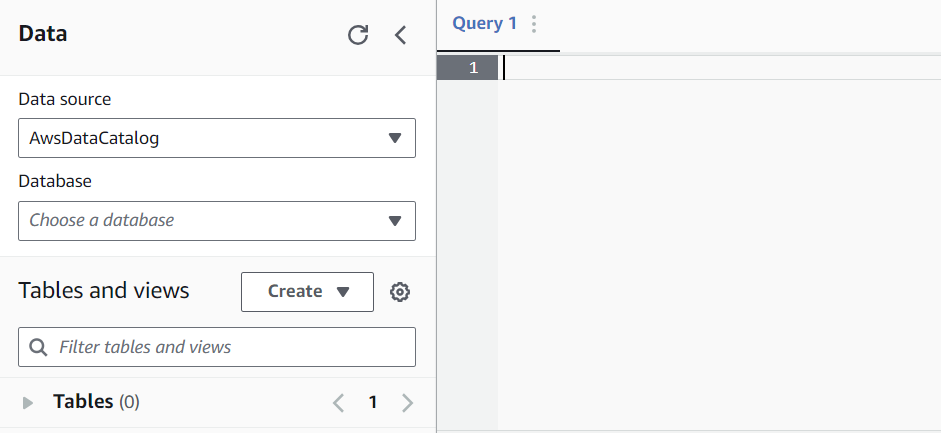
To create our first database, we will run the following query:
CREATE DATABASE mydatabaseRunning this query will allow you to select a database from the dropdown below “Database” on the left sidebar.
Now that we have a database, we will focus on creating a table so we have something to query!
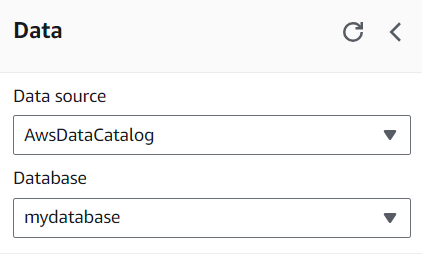
Getting data into your database will differ slightly based on your AWS setup. You can utilize data stored in a data warehouse like Redshift or streaming data utilizing AWS Kinesis and Lambda to generate tabular data.
Today, we will use sample data from sample AWS Cloudfront Logs. Because of the data complexity, part of the creation process uses RegEx groups to parse URl data into columns.
Using the following SQL, we can create a table. Note: below, replace “myregion” with your AWS region.
CREATE EXTERNAL TABLE IF NOT EXISTS cloudfront_logs (
Date DATE,
Time STRING,
Location STRING,
Bytes INT,
RequestIP STRING,
Method STRING,
Host STRING,
Uri STRING,
Status INT,
Referrer STRING,
os STRING,
Browser STRING,
BrowserVersion STRING
)
ROW FORMAT SERDE 'org.apache.hadoop.hive.serde2.RegexSerDe'
WITH SERDEPROPERTIES (
"input.regex" = "^(?!#)([^ ]+)\\s+([^ ]+)\\s+([^ ]+)\\s+([^ ]+)\\s+([^ ]+)\\s+([^ ]+)\\s+([^ ]+)\\s+([^ ]+)\\s+([^ ]+)\\s+([^ ]+)\\s+[^\(]+[\(]([^\;]+).*\%20([^\/]+)[\/](.*)If the table appears on the left sidebar, you are ready to get started querying!
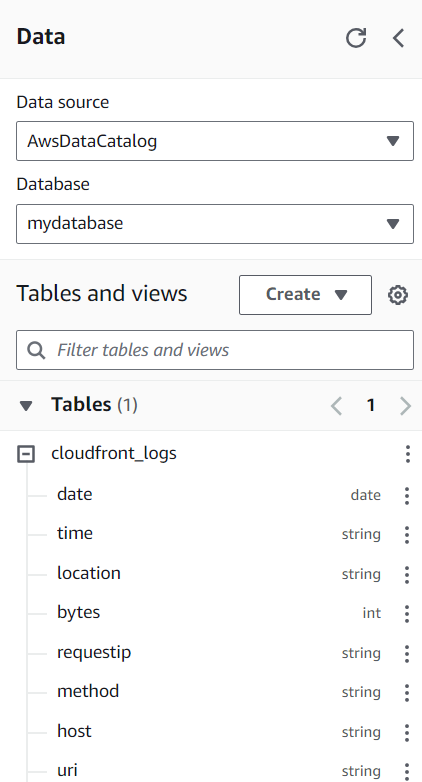
Writing and Running Queries in AWS Athena
Writing queries in Athena is similar to writing queries in traditional SQL. You simply write and submit the query to Athena, and the desired results are returned.
One best practice is to write your FROM statements with the following syntax: “DataSource”.”database”.”table”. That way, there is never any confusion about where the data is coming from.
Let’s try a simple SELECT statement to get us started.
SELECT *
FROM "AwsDataCatalog"."mydatabase"."cloudfront_logs"
LIMIT 10This should return a table with 10 results. Athena allows you to copy or download the results. At the same time, these results are saved to the S3 bucket you connected to your Athena service.

We can even write simple GROUP BY queries. This one, in particular, lets us know how many requestip (not necessarily unique) were involved with specific HTTP methods.
SELECT
method,
COUNT(requestip)
FROM "AwsDataCatalog"."mydatabase"."cloudfront_logs"
GROUP BY 1A great way to utilize Athena is for more complex queries like window functions. Because of Athena’s optimization, we can perform complicated computations more quickly.
For instance, we can use Athena to generate the ROW NUMBER() for each record partitioned by their region and date organized by time descending. We can then pick the most recent record for each region and date using a WHERE filter to pick the first row.
SELECT *
FROM (
SELECT
location,
date,
time,
ROW_NUMBER() OVER(PARTITION BY location, date ORDER BY time DESC) row_num
FROM "AwsDataCatalog"."mydatabase"."cloudfront_logs"
)
WHERE row_num = 1
This is just the beginning with Athena. You can continue to write any query you think will allow you to leverage Athena’s capabilities.
Best Practices for Using AWS Athena
AWS Athena requires a series of best practices like any other data processing tool. These practices will not only make your life easier but also improve its performance.
Additionally, since AWS is a cloud-based service and users are charged based on various storage and computational factors, these practices can lead to significant cost savings!
Optimizing data formats (e.g., Parquet, ORC)
Various data formats are more handy to utilize in AWS Athena. Since Athena pulls from an S3 bucket, choosing a data format that is easy to read and is compressed will improve performance and cost.
Raw data stored in CSV may be the most straightforward but inefficient. Storing our data in a compressed format like Parquet or ORC format will save on data read costs.
An additional benefit of Parquet and ORC is their columnar-based compression. Athena’s optimizer allows it to look only for particular data columns instead of working through the entire table to perform calculations.
Partitioning data to improve query performance
Partitioning data means regularly splitting up a dataset based on a particular key, such as a date. For example, we may have daily partitions where the data is set up to be automatically divided and stored by days.
When our data is partitioned, the SQL engine can perform better optimization by looking at relevant partitions. This leads to a direct improvement in reducing the amount of scanned data, reducing overall cost.
Managing costs by optimizing queries
While some complexity is expected when performing data analysis, optimizing queries can help reduce computational time and cost. Some of the costs are not directly from Athena but from other services that AWS Athena utilizes.
The main component of Athena’s cost is scanning and processing data, but you may incur costs from S3 if you save huge results. We can also improve query performance and reduce costs by ensuring queries are optimized following the usual SQL best practices.
For instance, all of the following will help with optimization:
- Filter data as possible to reduce the size of the dataset being worked on
- Carefully join datasets to minimize excess computation
- Avoid using
SELECT *where possible - Use
LIMITwhen testing queries
These best practices will improve query performance and reduce cost!
Monitoring and troubleshooting queries
AWS Athena can connect to Amazon CloudWatch to store query metrics. We can discover inefficient queries or problems by looking at query performance logs.
Integrating AWS Athena with Other AWS Services
As mentioned, AWS Athena integrates with several other AWS services, enhancing its data cataloging, visualization, processing, and warehousing capabilities.
Below is how Athena works with services like AWS Glue, Amazon QuickSight, AWS Lambda, and Amazon Redshift.
Data Cataloging and ETL with AWS Glue
When integrated with AWS Athena, AWS Glue is a central metadata repository that automatically catalogs data in Amazon S3. This integration eliminates the need for manual schema definitions, streamlining data querying in Athena.
Glue also provides ETL capabilities, transforming and preparing data for optimal querying in Athena by automating tasks like data compression, partitioning, and format conversion, ensuring efficient and effective data processing.
Data Visualization with Amazon QuickSight
Amazon QuickSight integrates with AWS Athena to turn query results into interactive dashboards and reports. This connection allows you to visualize data directly from Athena queries, enabling quick and easy creation of visual insights.
QuickSight supports features like automated data refreshes and advanced analytics, making it a powerful tool for exploring and presenting data.
Serverless Data Processing with AWS Lambda
AWS Lambda automates data processing workflows with Athena in a serverless environment. Lambda functions can trigger Athena queries in response to events, such as new data in S3, enabling real-time processing.
Lambda can also automate subsequent actions based on query results, creating scalable, event-driven workflows without manual intervention.
Data Warehousing with Amazon Redshift
While Athena is ideal for ad-hoc S3 data querying, Amazon Redshift offers a robust, structured, and complex analytics solution. You can use Athena for quick analysis of raw data and Redshift for more intensive, high-performance queries.
The integration allows data movement between S3 and Redshift, leveraging the strengths of both services for a comprehensive analytics solution.
Conclusion
AWS Athena is a powerful query engine built right into the AWS ecosystem. By allowing users to quickly access data stored in S3 buckets while saving query results to S3 buckets, AWS Athena empowers users to dive into their data more flexibly. It reaps the benefits of other AWS services, such as being serverless, scalable, and straightforward.
If you want to learn more about AWS, DataCamp offers various resources:
Become a Data Engineer
FAQs
Can AWS Athena be used with data stored outside of Amazon S3?
While AWS Athena is primarily designed to query data stored in Amazon S3, it can be extended to query data from other sources using AWS Athena Federated Query. Using data source connectors, this feature allows you to query data across multiple data stores, such as relational databases, on-premises data sources, and other cloud services.
How does Athena handle schema changes in data over time?
AWS Athena handles schema changes through the AWS Glue Data Catalog, which supports schema versioning and evolution. This allows you to manage and track changes in your data schema over time, ensuring that queries remain consistent and accurate even as your data structure evolves.
Is there a limit to the data size that Athena can query in a single request?
Athena doesn’t impose a hard limit on the size of the data it can query. However, the performance of queries may vary depending on the size and complexity of the data. Best practices, such as partitioning and compressing data, can help optimize query performance on large datasets.
How does AWS Athena compare with Google BigQuery?
AWS Athena and Google BigQuery are serverless query engines for large-scale data analysis. While they share similarities, key differences include pricing models, integration with other cloud services, and native support for different data formats. BigQuery typically uses a flat-rate or on-demand pricing model, whereas Athena uses a pay-per-query pricing model. Additionally, integration and ease of use might differ depending on your existing cloud infrastructure and requirements.
Can I schedule queries in AWS Athena to run automatically?
You can schedule queries in AWS Athena using AWS services like AWS Lambda and Amazon CloudWatch Events. By creating a scheduled event in CloudWatch, you can trigger a Lambda function that runs a specific Athena query at defined intervals, allowing for automated and recurring data analysis tasks.
I am a data scientist with experience in spatial analysis, machine learning, and data pipelines. I have worked with GCP, Hadoop, Hive, Snowflake, Airflow, and other data science/engineering processes.


